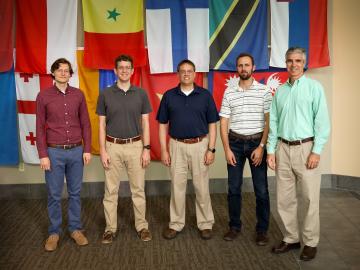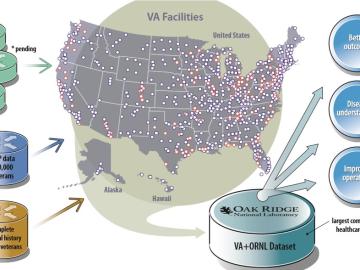
Filter News
Area of Research
- (-) Supercomputing (121)
- Advanced Manufacturing (11)
- Biological Systems (4)
- Biology and Environment (67)
- Building Technologies (2)
- Clean Energy (164)
- Climate and Environmental Systems (3)
- Computational Engineering (2)
- Computer Science (10)
- Data (1)
- Electricity and Smart Grid (1)
- Energy Sciences (1)
- Fossil Energy (1)
- Fuel Cycle Science and Technology (1)
- Fusion and Fission (19)
- Fusion Energy (9)
- Isotope Development and Production (2)
- Isotopes (15)
- Materials (152)
- Materials Characterization (2)
- Materials Under Extremes (1)
- National Security (31)
- Neutron Science (72)
- Nuclear Science and Technology (19)
- Quantum information Science (3)
- Sensors and Controls (1)
- Transportation Systems (2)
News Topics
- 3-D Printing/Advanced Manufacturing (1)
- Advanced Reactors (1)
- Artificial Intelligence (20)
- Big Data (8)
- Bioenergy (4)
- Biology (4)
- Biomedical (4)
- Biotechnology (2)
- Chemical Sciences (1)
- Climate Change (9)
- Computer Science (36)
- Coronavirus (1)
- Critical Materials (1)
- Cybersecurity (4)
- Decarbonization (2)
- Energy Storage (2)
- Environment (8)
- Exascale Computing (14)
- Frontier (17)
- Grid (1)
- High-Performance Computing (18)
- Machine Learning (4)
- Materials (5)
- Materials Science (1)
- Microscopy (1)
- Nanotechnology (3)
- National Security (3)
- Net Zero (1)
- Neutron Science (2)
- Nuclear Energy (3)
- Physics (2)
- Quantum Computing (7)
- Quantum Science (8)
- Security (2)
- Simulation (9)
- Software (1)
- Space Exploration (2)
- Summit (15)
- Sustainable Energy (3)
- Transportation (2)
Media Contacts

A team of scientists led by Oak Ridge National Laboratory used machine learning methods to generate a high-resolution map of vegetation growing in the remote reaches of the Alaskan tundra.
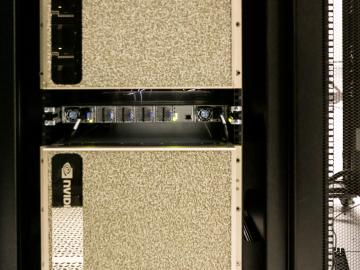
As home to three top-ranked supercomputers of the last decade, the US Department of Energy’s (DOE’s) Oak Ridge National Laboratory (ORNL) has become synonymous with scientific computing at the largest scales. Getting the most out of these science machines, however, requires a w...

Scientists at Oak Ridge National Laboratory and Hypres, a digital superconductor company, have tested a novel cryogenic, or low-temperature, memory cell circuit design that may boost memory storage while using less energy in future exascale and quantum computing applications.

By analyzing a pattern formed by the intersection of two beams of light, researchers can capture elusive details regarding the behavior of mysterious phenomena such as gravitational waves. Creating and precisely measuring these interference patterns would not be possible without instruments called interferometers.

Deep neural networks—a form of artificial intelligence—have demonstrated mastery of tasks once thought uniquely human. Their triumphs have ranged from identifying animals in images, to recognizing human speech, to winning complex strategy games, among other su...
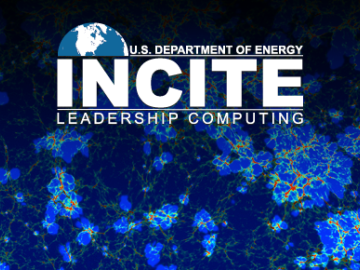
The U.S. Department of Energy’s Office of Science announced 55 projects with high potential for accelerating discovery through its Innovative and Novel Computational Impact on Theory and Experiment (INCITE) program. The projects will share 5.95 billion core-hours on t...
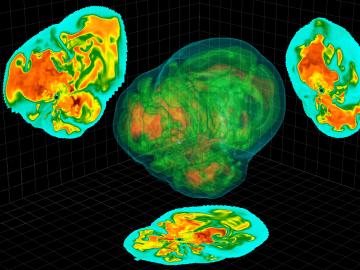
The Big Bang began the formation and organization of the matter that makes up ourselves and our world. Nearly 14 billion years later, nuclear physicists at the Department of Energy’s Oak Ridge National Laboratory (ORNL) and their partners are using America’s most powerful supercomp...

The field of “Big Data” has exploded in the blink of an eye, growing exponentially into almost every branch of science in just a few decades. Sectors such as energy, manufacturing, healthcare and many others depend on scalable data processing and analysis for continued in...
